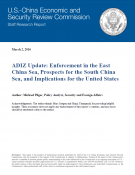Research: Security and Foreign Affairs
Research

This report assesses the extent to which China has enforced its air defense identification zone (ADIZ) in the East China Sea, and considers the potential conditions and implications of a Chinese ADIZ in the South China Sea.
Research
In February 2015, China and Argentina announced prospective weapons sales and defense cooperation agreements extending beyond the scope of any made between China and a Latin American nation to date. These plans include Argentina’s purchase or coproduction of 14-20 fourth-generation fighter aircraft, at least 100 armored personnel carriers, and five naval vessels; enhanced military-to-military exchanges; and China’s construction in Argentina of a space tracking facility in conjunction with satellite imagery sharing. If fulfilled, these agreements would vastly surpass China’s previous regional arms exports in value and achieve several new benchmarks in the breadth, competitiveness, and technological sophistication of its regional arms sales; altogether representing a new phase in China-Latin America defense engagement. These developments would present several implications for U.S. objectives in the region: U.S. arms suppliers would likely see continued market share reduction, the United States may face a new regional security hazard, regional actors might alter their political stances or use Chinese arms in ways unfavorable to U.S. interests, and the Falkland Islands dispute might briefly and temporarily intensify. Despite the rapid growth and proximity of China’s regional defense engagements, however, they present no direct security threat to the United States.
Research
This Issue Brief examines the U.S. Navy’s recent freedom of navigation patrol in the South China Sea, and discusses what China, the United States, and the rest of the region might do next in the South China Sea. The last time U.S. military ships and aircraft sailed or flew within 12 nautical miles (nm) of Chinese-occupied features in the Spratly Islands was 2012. On October 27, however, a U.S. Navy guided missile destroyer conducted a freedom of navigation patrol within 12 nm of Subi Reef, a land feature on top of which China has built an artificial island. Reportedly, the patrol “was completed without incident,” though China’s navy sent two ships to monitor and issue warnings to the U.S. destroyer. The U.S. ship also conducted freedom of navigation operations within 12 nm of land features occupied by Vietnam and the Philippines.
The objective of the freedom of navigation patrol appears to have been to signal that the U.S government does not consider China to have sovereignty over the 12 nm area of sea adjacent to Subi Reef. Transforming a low-tide elevation into an artificial island does not entitle it to a territorial sea. The patrol did not make a statement about the validity of China’s sovereignty claim over Subi Reef itself.
Research
In April 2015, the U.S. Office of Naval Intelligence confirmed that China has deployed the YJ-18 antiship cruise missile (ASCM) on some People’s Liberation Army (PLA) Navy submarines and surface ships. The YJ-18’s greater range and speed than previous Chinese ASCMs, along with its wide deployment across PLA platforms, would significantly increase China’s antiaccess/area denial capabilities against U.S. Navy surface ships operating in the Western Pacific during a potential conflict. The YJ-18 probably will be widely deployed on China’s indigenously built ASCM-capable submarines and newest surface ships by 2020, and China could develop a variant of the YJ-18 to replace older missiles in its shore-based ASCM arsenal. This paper assesses the capabilities of the YJ-18 and describes the implications of its wide deployment for U.S. forces operating in the Western Pacific. The author exclusively used open source information and considered the capabilities of similar missiles to assess the likely characteristics of the YJ-18.
Research
This Staff Report assesses the political realities that have limited Taiwan’s participation in global fisheries management, and the ways by which Taiwan has leveraged the size, geographic range, and technical capabilities of its fishing industry to take modest and pragmatic steps to expand its participation in bilateral, regional, and international fisheries-related agreements.
